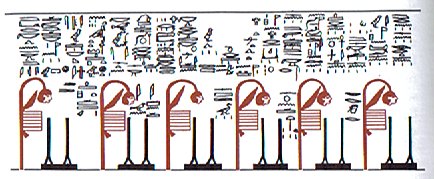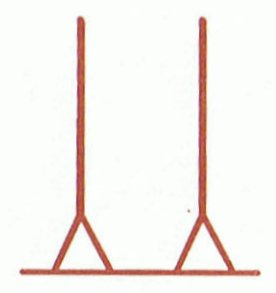 |
 |
 |
 |
|
Ha5-33 |
Ha5-34 |
Ha5-35 |
Ha5-36 |
 |
 |
 |
 |
|
Pa5-15 |
Pa5-16 |
Pa5-17 |
Pa5-18 |
 |
 |
 |
 |
|
Qa5-23 |
Qa5-24 |
Qa5-25 |
Qa5-26 |
The arms held high in the
first two columns possibly are drawn to illustrate the
shape of the waning moon sickle as seen from south of the equator, a
sign (presumably) that 'noon' has passed.
If we compare the ihe
shapes in the last two columns with the sickle-shapes in
the first two columns, we can see that in P both shapes
are shorter and thicker than the parallel shapes in Q
(and presumably also in H). Maybe the correlation means that we
should interpret ihe as half a moon sickle.
Half of
waning moon means ½ of the 4 periods of waning moon,
which could explain why there are two ihe-maro
glyphs.
The 8-fold structure could
mean that the 8 glyphs (in the four parallel texts)
represent a short
moon calendar.
But the structure could
equally well be used to map the yearly voyage of the
sun. 360º (360 days) for 8
equally long periods would result in 45º (45 days) for
each such period / glyph.
I think that the structures
for moon and sun very well may be the same. The
8 periods of the moon may be an influence from the fact
that dividing 360 repeatedly by 2 is not possible more
than 4 times - after that a further division would
result in the unacceptable 22½.
364 does not have
room for more than 3 successive such divisions; is that
one of the reasons why the measure of 'earth' is 3 from
a 'female' view, but 4 from a 'male' view?
Given that ihe is a
picture of ½ a waning moon sickle, it is understandable
that ihe is associated with death.
In Hawaii
'The-Companion-of-the-King', the one who is also known
as Death-is-Near (Koke-na-make) is the king's
'living god' (Kahoali'i), a close kinsman and the
king's double during the New Year ceremonies.
In ancient Egypt the sungod
was accompanied during his 'night' journey by a strange
figure, here sitting in front of him:

According to Wilkinson this
figure (schemset) symbolized the
king's acestors from a far away time, his 'follower'. This
notion reminds me about the way the Polynesians always
in their minds keep their ancestors close in front of
them.
The picture shows a
schemset with the sign of a knife (top right). The
knife (says Wilkinson) is fastened with a rope to a
staff and the leg (bottom right) is the handle of the
knife (a leg as a kind of wordplay on
'follower').
I doubt that
we can see a rope coiled 7 times around the staff,
instead I see 7 henua on top of each other.
In the
hieroglyphic sign of schemset the midpart may
be interpreted - I guess - as illustrating 2 squares
('earths') divided in 2 by diagonals, i.e. two
half-years each containing 2 quarters:

Maybe we
should imagine this hieroglyph as a boat by turning it
90º around:

Another picture (from
Wilkinson) showing 'the follower' is this:

Here there are 6
semschet and each has 6 henua-like signs at
their middles, i.e. 36 altogether.
The knives
have different lengths and the 3 at right are longer
than the first 3. The knives seem to have severed the 6
hanging heads.
There are
also 6 'inverted double Y:s' in the picture. Such an
'inverted double Y' shows the hieroglyphic sign
menchet:

Wilkinson
tells us that this hieroglyph represents 'cloth'.
Immediately I think (like a Polynesian) of cloth as a sign of the female.
Semschet seems to be male (arriving first) and
menchet female (arriving as second).
Is it
possible that the rongorongo Y-sign has been
designed after having seen menchet?
Now we will have a quick
look at Mafdet, a catlike ancient Egyptian
creature similar to what we often can see climbing
henua (e.g. Eb3-19):

According to Wilkinson
Mafdet was a goddess and a 'manifestation of the
protecting and punishing aspect' of semschet:

"In early Egyptian
mythology, Mafdet (also spelt Maftet)
was the deification of legal justice, or
rather of execution. Thus she was also
associated with the protection of the
king's chambers and other sacred places,
and with protection against venomous
animals, which were seen as
transgressors against Ma'at.
Since venomous animals
such as scorpions and snakes are killed
by felines, Mafdet was seen as a feline
goddess, although it is uncertain
whether she was meant to be a cat,
panther, or mongoose. In reflection of
the manner in which these animals kill
snakes, her name means (she who) runs
swiftly, and she was given titles such
as slayer of serpents.
In art, Mafdet was shown
as a feline, or a woman with a feline
head, or a feline with a woman's head,
sometimes with braided hair which ended
in the tails of scorpions. She was also
depicted as a feline running up the side
of an executioner's staff. It was said
that Mafdet ripped out the hearts of
wrong-doers, delivering them personally
to the pharaoh's feet, in a similar
manner as domestic cats present people
with rodents or birds that they have
killed or maimed. During the New
Kingdom, Mafdet was seen as ruling over
the judgement hall in Duat.
Her cult was eventually
replaced by that of Bast, another
cat-goddess, who was seen as the
pharaoh's protector." (Wikipdia)











